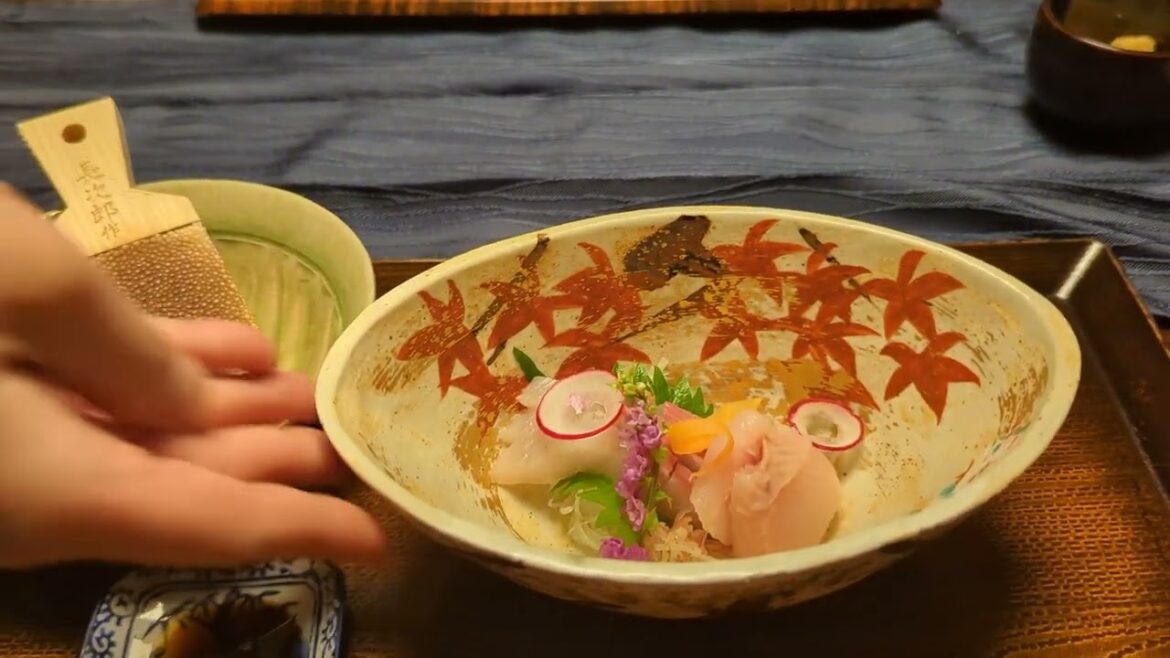We were served an extravagant kaiseki dinner in a private room during our stay at Sui Suwako (萃sui 諏訪湖), a boutique luxury ryokan with just 8 rooms located in Laka Suwa, Nagano, Japan (長野県諏訪湖.) The explanation, however, was all in Japanese, so here is a description of each course (to the best of my ability!)…
COURSE 1 – HASSUN (八寸 – Seasonal Assortment Platter):
* Kikuna no Ohitashi to Ikura (菊菜お浸しといくら – Crown Daisy and Salmon Roe in cold Dashi broth. Crown Daisy is the flower of a Chrysanthemum)
* Amaebi Uruka-ae (甘海老うるか和え – Sweet Shrimp with Salted and spiced Sweetfish and Miso Soybean paste)
* Renkon Sembei (蓮根煎餅 – Crispy Lotus Root cracker)
* Yaki Meguri (焼き目栗 – Roasted Chestnut)
* Kuruma-ebi (車海老 – Japanese Tiger Prawn)
* Daitokuji Natto Matsuba-sashi (大徳寺納豆松葉刺し – Fermented, cured and salted Soybeans on a pine needle)
* Kinoha Nankin (木の葉南瓜 – Steamed Kabocha Japanese Squash arranged to look like a leaf)
* Hanjuku Tamago (半熟卵 – Soft-boiled egg)
* Kamo Rosu (鴨ロース – Smoked Duck)
* Hoshiko (干し子 – 海鼠の卵巣 – Grilled Sea Cucumber Ovaries)
* Shio Aburi Shin-Ginnan (塩炙り新銀杏 – Salted and lightly seared Gingko Nut)
* Shimeji Karasumi-ae (占地からすみ和え – Shimeji Mushrooms with Mullet Roe)
* Ginnan Maruju (銀杏丸十 – Gingko Nut-shaped Japanese Sweet Potato)
COURSE 2 – AGEMONO (揚げ物 – Deep-fried Dish):
* Wakasagi Tempura (ワカサギの天ぷら – Japanese Smelt Tempura) from Lake Suwa
COURSE 3 – OWANMONO (椀物 – Clear Soup Dish):
* Momijidai to Matsutake no Shabu-nabe (紅葉鯛と松茸のしゃぶ鍋 – Red Sea Bream caught in the Autumn and Matsutake Mushrooms Shabu Shabu hot pot soup)
– Mizuna (水菜 – Japanese Mustard)
COURSE 4 – OTSUKURI (お造り – Sashimi):
* Shinano Yukimasu (信濃雪鱒 – Shinano Yukimasu Snow Trout from the Shinano River)
* Shinshu Oo Iwana (信州の大岩魚 – White-spotted Char from Shinshu)
COURSE 5 – YAKIMONO (焼き物 – Grilled Dish):
* Shinshu Salmon Yuan-yaki (信州サーモン柚庵焼き – Grilled Shinshu Freshwater Salmon that’s been marinated in a mixture of soy sauce, sake, sugar, mirin and citrus fruit)
– Ao Togarashi (青唐辛子 – Green Japanese Peppers)
COURSE 6 – Nakasara (中皿 – Chuzara – Middle Dish):
* Shinshu Soba (信州蕎麦 – Shinshu Soba noodles)
– Tororo (とろろ – Grated Nagaimo Mountain Yam)
COURSE 7 – DAINOMONO (台の物 – Food Placed on a Stand):
* Iroiro Kinoko no Nabe (色々きのこの鍋 – Assorted Mushrooms Hot Pot)
– Shinshu Gyu (信州牛 – Shinshu Beef)
– Hokkaido Hotate (北海道帆立 – Hokkaido Scallops)
– Mie Hirame (三重平目 – Flounder/Sole/Flat Fish from Mie Prefecture)
– Kani (蟹 – Crab)
– Unagi (鰻 – Eel)
COURSE 8 – OSHOKUJI (お食事 – Rice Dish):
* Kisetsu no Donabe Gohan (季節の土鍋ご飯 – Seasonal Rice cooked in a clay pot)
– Iiyama Koshihikari (飯山産コシヒカリ新米 – Newly-harvested Iiyama Koshihikari Rice)
– Gyu Shigure-ni (牛時雨煮 – Stewed Wagyu Beef flavored with ginger and soy sauce)
– Shoyumame (しょうゆ豆 – Parched broad beans that have been left overnight in a marinade consisting primarily of soy sauce and sugar, with mirin and sake usually included in the marinade as well)
– Yakinori (焼きのり – Salt-grilled Nori Seaweed)
– Katsuobushi (鰹節 – Shaved dried Bonito flakes)
– Nameko (なめこ – Nameko Mushrooms)
COURSE 9 – KOUNOMONO (香の物 – Pickled Vegetables):
* Jikasei Otsukemono (自家製お漬物 – Seasonal Tsukemono pickled vegetables)
– Nasu (茄子 – Japanese Eggplant)
– Kyuri Karashi-zuke (胡瓜辛子漬け – Cucumber dressed with Japanese yellow mustard)
– Korinki (コリンキー – Korinki Japanese Squash)
COURSE 10 – AKADASHI (赤出汁 – Red Miso Soup):
– Aosa Nori (青さ海苔 – Aosa Nori Seaweed)
– Ito Kanten (糸寒天 – A gelatinous substance made from seaweed, shaped like a thread)
COURSE 11 – KASHI (菓 – Dessert):
* Aki no Wa-Parfait (秋の和パフェ – Fall Japanese Parfait)
– Vanilla Ice Cream (バニラアイス)
– Nama Cream (生クリーム – Whipped Cream)
– Kuri (栗 – Chestnut)
– Shine Muscat (シャインマスカット – Shine Muscat Grape)
– Kyoho Budo (巨峰葡萄 – Kyoho Grape)
– Shiratama (白玉 – Shitatama. Shiratama is a Japanese “dango” dumpling made from rice flour mixed with uruchi rice flour and glutinous rice flour. It is different from the method of making mochi, which is made after steaming glutinous rice)
– Anpo-gaki (あんぽ柿 – Anpo-gaki Japanese semi-dried Persimmons)

